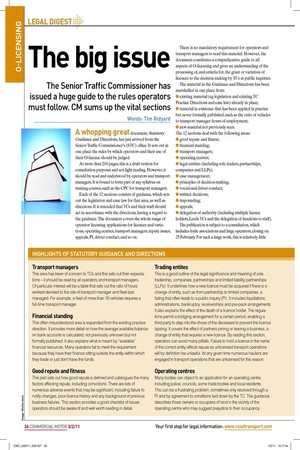The big issue
Page 21

If you've noticed an error in this article please click here to report it so we can fix it.
The Senior Traffic Commissioner has issued a huge guide to the rules operators must follow. CM sums up the vital sections
Words: Tim Ridyard A whopping great document, Statutory Guidance and Directions, has just arrived from the Senior Trafic Commissioner’s (STC) ofice. It sets out in one place the rules by which operators and their use of their O-licence should be judged.
At more than 200 pages, this is a draft version for consultation purposes and not light reading. However, it should be read and understood by operators and transport managers. It is bound to form part of any syllabus on training courses, such as the CPC for transport managers.
Each of the 12 sections consists of guidance, which sets out the legislation and case law for that area, as well as directions. It is intended that TCs and their staff should act in accordance with the directions, having a regard to the guidance. The document covers the whole range of operator licensing: applications for licences and variations, operating centres, transport managers, repute issues, appeals, PI, driver conduct, and so on. There is no mandatory requirement for operators and transport managers to read this material. However, the document constitutes a comprehensive guide to all aspects of O-licensing and gives an understanding of the processing of, and criteria for, the grant or variation of licences to the decision making by TCs at public inquiries.
The material in the Guidance and Directions has been marshalled in one place from: ● existing material (eg legislation and existing TC Practice Directions and case law) already in place; ● material in existence that has been applied in practice but never formally published, such as the ratio of vehicles to transport manager hours of employment; ● new material not previously seen. The 12 sections deal with the following areas: ● good repute and itness; ● inancial standing; ● transport managers; ● operating centres; ● legal entities (including sole traders, partnerships, companies and LLPs); ● case management; ● principles of decision-making; ● vocational driver conduct; ● written decisions; ● impounding; ● appeals; ● delegation of authority (including multiple licence holders, Leeds TCs and the delegation of functions to staff).
The publication is subject to a consultation, which includes trade associations and large operators, closing on 25 February. For such a large work, this is relatively little













































